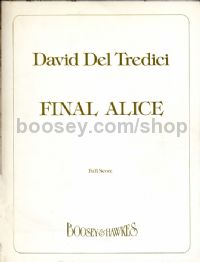Final Alice (Full Score)
Final Alice (Full Score)
* Estimated price converted from UK retail price
Composer's Notes
Final Alice is a series of elaborate arias, interspersed and separated by dramatic episodes from the last two chapters of Alice's Adventures in Wonderland, centering around the Trial in Wonderland (which gradually turns to pandemonium) and Alice's subsequent awakening and return to 'dull reality.' To this I have added an Apotheosis.
Final Alice teeters between the worlds of opera and concert music. It is, on the one hand, opera-like in its dramatic continuity, its arias, its different characters. On the other hand, it is a Grand Concerto for voice and orchestra, as a single person must perform all these various functions (maintaining then the familiar concert hall confrontation between soloist and orchestra). If I were to invent a category for it, I would call Final Alice an "Opera, written in Concert Form."
Of the poems used, only texts of Arias I, II and V are by Lewis Carroll (and only the poem of Aria I appears in the Alice story). Arias II and IV are the Victorian originals. The relationship between these parodies and originals I found particularly intriguing and ultimately inspiring. Arias I and II are not only Carroll texts, but also two version of the same poem: Aria II is an earlier version not appearing in Alice. Both share the same world of confused pronouns and very little sense. Further, they first line of Aria II copies the first line of Alice Gray, a sentimental song by William Mee that was popular at the time. 'Did Carroll introduce Mee's poem into the story because the song behind it tells of the unrequited love of a man for a girl named Alice?' So queries Martin Gardner in a footnote from his book The Annotated Alice. Aria IV, 'Still more Evidence,' an extended setting of the poem "Alice Gray," is my answer. What moved me here was the desire not just to set the words 'at face value,' but rather to capture and convey the feelings those words must have aroused in the breast of the shy Oxford don. "Disillusioned," the second Victorian original, imitates closely the meter of "Alice Gray," but grotesquely distorts and mocks its sentiment. It is a cracked mirror-image; a devil's version of the angels' Alice. These two poems, Alice Gray and Disillusioned, are set side by side to music of the most violent contrast, as Aria III, 'Contradictory Evidence.'
Aria V is a setting of the concluding poem from the second Alice book, Through the Looking Glass. This poem is an acrostic, the initial letters of the lines spelling out the name of the 'real' Alice (ALICE PLEASANCE LIDDELL).
Final Alice tells two stories at once; primary is the actual tale of Wonderland itself, with all its bizarre and unpredictable happenings. All of these are painted as vividly as possible. But 'reading between the lines,' as it were, is the implied love story of Lewis Carroll and Alice Liddell, as suggested by the poems "Alice Gray" and the "Acrostic Song." By introducing these additional poems into the Trial as depositions of evidence, given by the White Rabbit (acting as a kind of chief prosecutor), I wished to bring that love story closer to the surface — not so much as to disturb the amusing, eccentric, sometimes terrifying story as it goes on and on in its inexorable fashion — but enough to leave a recognition; to add what one might call the human dimension of the man, seen only intermittently to be sure, but (one hopes) always affectingly, perhaps lingering in memory after the dream of Wonderland itself has faded.




